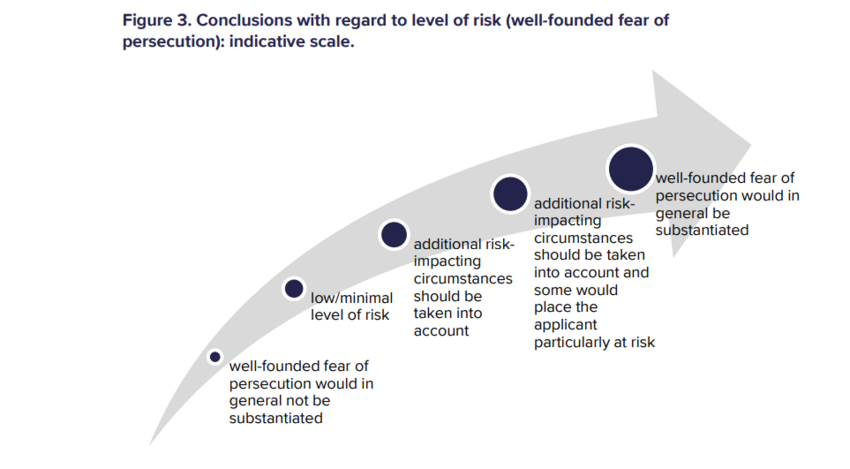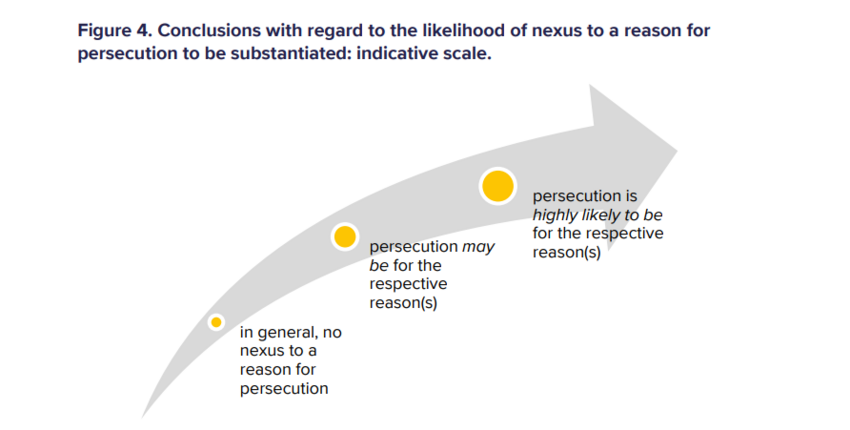This chapter contains some general considerations for the examination of refugee status.
The analysis is conducted in accordance with Article 9 QD and Article 10 QD and the general EUAA guidance on the topic.
There are a few things to remember when reading the sections within this chapter.
The chapter provides analysis and guidance on the situation of profiles of applicants identified as commonly encountered in the caseload of EU Member States. The included profiles represent a non-exhaustive list and the fact that a certain profile is included in it or not is without prejudice to the determination of their protection needs. Furthermore, the order of listed profiles does not reflect any assessment of their risk of persecution.
While the conclusions regarding the profiles could provide general guidance, the protection needs of each applicant should be examined individually. Furthermore, the conclusions may refer to sub-profiles at a differentiated risk and may include factors which could increase or decrease the risk of persecution. These aspects are to be taken into account in light of all circumstances in the individual case.
The individual applicant could fall under more than one profile included in the common analysis and guidance. The protection needs associated with all such circumstances should be fully examined.
In some cases, even if the applicant no longer belongs to a certain profile, they may still be targeted and have a well-founded fear of persecution related to their past belonging to such a profile. In the individual assessment, it may be relevant to take into account the time that has passed and whether the applicant had remained in the country of origin for a long period of time without encountering persecution.
Family members, merely due to their relation to an individual with a certain profile, may be at risk of persecution in such a manner that could constitute the basis for refugee status. This is not always explicitly mentioned within the conclusions regarding the respective profile but should be fully examined in the individual cases of family members fearing persecution due to their connection to an individual falling within the respective profile.
The considerations under each profile should be viewed without prejudice to the credibility assessment of the applicant’s claims. The common analysis and guidance note deal solely with issues of risk analysis and qualification, assuming that the ‘credibility of the profile’ has been established.
While the country guidance document is not intended to inform the credibility assessment, the COI, which has been used as a basis to provide its general assessment and guidance, may be a helpful reference to examine credibility. In this regard, the reader may find it useful to access the COI documents linked from the respective common analysis sections.
Step-by-step approach
Country guidance documents follow a step-by-step approach with regard to the analysis whether the qualification criteria under refugee status are met.
Each profile has a similar outline, including the following features.
This is an indication when the analysis and guidance were last reviewed and updated, similarly to all other sections in the document.
Most profiles and some sub-profiles include a definition of scope. This indicates the type of individuals which the section concerns, making note of potential limitations to the scope of the profile. This is meant to assist the reader in ascertaining whether the individual applicant whose claim they are examining would fall within the scope of the respective section. See COI summaries.
This indicates the sections of the EUAA COI reports and queries that the analysis has been based on. Links to the relevant reports and queries are also included for ease of reference, further highlighting that Country Guidance should not be referred to as source of COI. See COI summaries.
The 'risk-analysis' sub-section answers two questions on the basis of the COI summary:
Do the acts reported to be committed against individuals belonging to this profile reach the level of persecution?
This analysis is conducted under Article 9 QD. It may conclude that the acts amount to persecution when they, due to their nature or repetitiveness, reach the required threshold of severity (Article 9(1)(a) QD).
The assessment may also refer to the potential accumulation of various measures, including violations of human rights, which is sufficiently severe as to affect an individual in a similar manner as mentioned in point (a) (Article 9(1)(b) QD).
Furthermore, reference to specific acts under Article 9(2) QD may be made where relevant.
What is the level of risk for the profile and/or for sub-categories identified within the profile?
If the acts reported to be committed against individuals within this profile amount or may amount to persecution, the analysis moves forward to a second step, which examines the level of risk, i.e. how likely it is for applicants within the profile to have a well-founded fear of persecution.
The conclusions regarding the level of risk could be broadly illustrated on an indicative scale, see Figure 3 below.
Note that an individual examination is required in all cases.
For a better understanding of the different wording used in these conclusions, see Terminology notes.
If well-founded fear of persecution is established, the analysis should proceed with the examination of the existence of a nexus to a reason for persecution.
Article 9 (3) of the recast Qualification Directive
In accordance with point (d) of Article 2, there must be a connection between the reasons mentioned in Article 10 and the acts of persecution as qualified in paragraph 1 of this Article or the absence of protection against such acts.
The next step in the analysis of refugee status protection needs is, therefore, the presence of a reason for persecution falling within the provision of Article 10 QD.
The assessment in this regard is based on the COI summary. In most cases, the conclusion would be made in relation to the nexus between the feared acts and the respective reasons for persecution. However, in some cases, the COI may also or alternatively support a finding of a nexus between the absence of protection and the reason in question.
The indicated reason or reasons are those identified as most relevant on the basis of the available COI. This is without prejudice to the potential applicability of a different or additional reason in individual cases.
The formulations of the conclusions within this section can also be illustrated on an indicative scale, according to the likelihood of a nexus being substantiated in the individual examination, see Figure 4 below.
As above, the conclusions are not of absolute nature and are not intended to automatically lead to the granting of refugee status or not. An individual examination is required.
If the threshold for well-founded fear of persecution is met for the applicant, but no nexus to a reason for persecution is substantiated, the examination should proceed to consider subsidiary protection needs.
For some profiles, or categories of individuals within them, exclusion considerations may be relevant. A reminder regarding exclusion considerations is hence included in sections identified as particularly relevant based on the available COI. These aim to alert and assist the reader by referring them to the dedicated chapter Exclusion.



